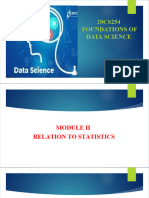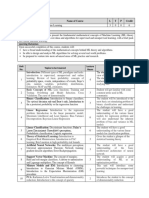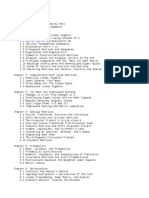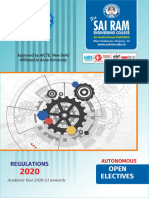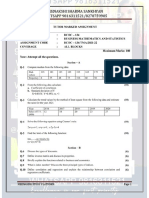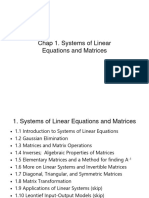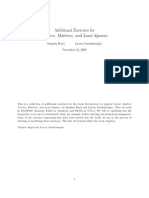Basic Concepts of Probability, Linear Algebra and Optimization for
understanding Machine Learning:
Here’s a concise overview of the basic concepts in Probability, Linear Algebra,
and Optimization that are foundational to understanding Machine Learning (ML):
1. Probability
Probability theory is crucial in ML for handling uncertainty, making predictions,
and modeling random events. Here are key concepts:
Random Variables: These represent outcomes of random processes. A
random variable can be discrete (taking distinct values) or continuous
(taking any value in a range).
Probability Distribution: Describes how probabilities are distributed over
possible values of a random variable. Common distributions include:
o Discrete: Binomial, Poisson, Geometric.
o Continuous: Normal (Gaussian), Exponential, Uniform.
Conditional Probability: The probability of an event occurring given that
another event has already occurred. Denoted as P(A∣B)P(A|B)P(A∣B), it’s
fundamental in algorithms like Naive Bayes and for understanding concepts
like overfitting and generalization.
Bayes’ Theorem: A formula for updating the probability of a hypothesis
based on new evidence. It’s key in Bayesian inference, used in models like
Naive Bayes classifiers and in posterior updating in many ML algorithms.
Expectation and Variance:
o Expected Value (Mean): Average outcome of a random variable.
o Variance: Measures how spread out the values of the random
variable are.
Independence: Two events are independent if the occurrence of one
doesn’t affect the probability of the other.
Law of Large Numbers: As the number of trials increases, the sample mean
will approach the expected value.
Page 1 of 8
�In ML, we use probability for classification (e.g., Logistic Regression), regression
(e.g., Bayesian Linear Regression), and more advanced algorithms like Hidden
Markov Models and Gaussian Mixture Models.
2. Linear Algebra
Linear algebra provides the mathematical foundation for dealing with data,
especially when it's represented as vectors or matrices, which is common in ML.
Vectors: A vector is an ordered list of numbers (elements), representing a
point in space. Vectors are used to represent data points in ML.
o Dot Product: Measures similarity between two vectors. Used in
algorithms like Linear Regression, Support Vector Machines (SVM),
and Neural Networks.
o Norm: The length (magnitude) of a vector. The Euclidean norm is
commonly used in machine learning (e.g., L2 norm in regularization).
Matrices: A matrix is a two-dimensional array of numbers, which can
represent multiple data points or features in ML. Operations on matrices
(multiplication, inversion, etc.) are foundational in many ML algorithms.
o Matrix Multiplication: Used extensively in transforming data, such as
in Neural Networks for forward and backward propagation.
o Identity Matrix: The matrix equivalent of "1" in scalar arithmetic,
useful for maintaining dimensional consistency.
o Determinant: Provides insights into the invertibility of a matrix (non-
zero determinant means the matrix is invertible).
o Inverse of a Matrix: If a matrix is invertible, multiplying it by its
inverse yields the identity matrix. It's used in solving systems of linear
equations (e.g., in Linear Regression).
Eigenvalues and Eigenvectors: Eigenvectors represent directions of
variance in data, and eigenvalues tell us how much variance is along those
directions. In PCA (Principal Component Analysis), eigenvectors and
eigenvalues help reduce data dimensions.
Linear algebra is central in representing and manipulating the data used in ML
models, such as in Principal Component Analysis (PCA) for dimensionality
reduction, or in Neural Networks for backpropagation and optimization.
Page 2 of 8
�3. Optimization
Optimization helps us find the best model parameters that minimize or maximize
an objective function. Many ML algorithms rely on optimization techniques to
train models.
Objective Function (Loss Function): The function we aim to minimize (or
maximize). In ML, it often quantifies the error or difference between the
predicted and actual outcomes. Examples:
o Mean Squared Error (MSE): Common in regression tasks.
o Cross-Entropy Loss: Common in classification tasks (e.g., in logistic
regression and neural networks).
Gradient Descent: A method for minimizing a loss function by iteratively
moving in the direction of the negative gradient (i.e., the steepest decrease
in error). It’s used in many ML models, especially in Neural Networks.
o Stochastic Gradient Descent (SGD): A variation of gradient descent
that updates the parameters using a single random data point at
each step.
Convex and Non-Convex Optimization:
o Convex Optimization: A problem where the objective function is
convex (a bowl-shaped curve), ensuring that there is a global
minimum. Linear regression and logistic regression are examples of
convex problems.
o Non-Convex Optimization: Problems with multiple local minima
(such as neural networks) where finding the global minimum is
harder.
Regularization: A technique used to avoid overfitting by adding a penalty
term to the loss function:
o L1 Regularization (Lasso): Adds the absolute value of coefficients to
the loss, promoting sparsity.
o L2 Regularization (Ridge): Adds the square of the coefficients to the
loss, preventing large coefficients.
Page 3 of 8
� Constraints: In optimization, constraints are conditions that the solution
must satisfy, such as in constrained optimization problems (e.g.,
constrained linear regression or SVM).
Optimization is crucial in training machine learning models, ensuring they fit the
data well without overfitting. It’s used in training algorithms like Linear
Regression, Neural Networks, and Support Vector Machines (SVMs).
Summary of How These Concepts Apply to Machine Learning:
Probability: Helps to model uncertainty, make predictions, and optimize for
models like Naive Bayes, Bayesian Networks, and in understanding
generalization.
Linear Algebra: Facilitates data representation (vectors, matrices), model
computation (dot products, matrix operations), and dimensionality
reduction (PCA).
Optimization: Guides the training process to minimize or maximize a given
function (like loss functions) using techniques like gradient descent.
These three areas together form the backbone of most machine learning
algorithms, from simple linear models to complex deep learning systems.
Page 4 of 8
�Basic Concepts of Linear Algebra, Digital Signal Processing (DSP), and Partial
Differential Equations (PDE) for understanding Deep Learning:
Let's break down the basic concepts from Linear Algebra, Digital Signal Processing
(DSP), and Partial Differential Equations (PDE) that are foundational for
understanding Deep Learning.
1. Linear Algebra
Linear algebra is fundamental to deep learning because it deals with vectors,
matrices, and their operations, which are essential for manipulating data in neural
networks.
Key Concepts:
Vectors: Arrays of numbers, representing points in space or data. In deep
learning, vectors can represent data inputs or the activations of a neuron
layer.
Matrices: 2D arrays of numbers. In deep learning, matrices are used to
represent weights and transformations applied to input data.
Matrix Multiplication: The core operation in neural networks for passing
data through layers. It’s used for transformations and combinations of data.
o Example: In a fully connected layer of a neural network, the input
vector is multiplied by a weight matrix to produce an output vector.
Dot Product: A scalar product of two vectors. It's the building block for
calculating how aligned two vectors are, often used in neural networks for
weighted sums in neurons.
Eigenvalues and Eigenvectors: These represent directions of greatest
variance in data, which is useful for understanding data representations
and reducing dimensions (e.g., PCA).
Systems of Linear Equations: Neural networks can be thought of as a
system of linear equations, where optimization techniques are used to
adjust the weights.
Page 5 of 8
�2. Digital Signal Processing (DSP)
Although DSP is typically used in audio and image processing, it also plays a role in
understanding how data transformations and filters work in deep learning.
Concepts from DSP are often applied in convolutional neural networks (CNNs) and
other deep learning methods.
Key Concepts:
Convolution: A mathematical operation that combines two functions to
produce a third. In deep learning, convolutions are used in CNNs for
filtering input data (e.g., images), to extract features like edges or textures.
o Example: In an image, a filter (kernel) is convolved with the input to
detect certain features.
Fourier Transform: A method to represent a signal in terms of its frequency
components. Deep learning models, especially in signal processing tasks
(like speech recognition), can benefit from understanding how data can be
transformed into frequency space.
Sampling and Aliasing: In DSP, data is often sampled from continuous
signals, and aliasing occurs if the signal is undersampled. In deep learning,
this concept helps in understanding how neural networks might overfit or
underrepresent data.
Filters: In DSP, filters are used to modify signals, which is conceptually
similar to how a neural network learns weights to modify inputs to extract
useful features.
3. Partial Differential Equations (PDEs)
PDEs describe systems that change over space and time. In deep learning, PDEs
often come into play in the context of optimization, physics-informed neural
networks, and understanding how information propagates through layers.
Key Concepts:
Gradient Descent: This optimization technique involves adjusting model
parameters (like weights) in the direction of the steepest gradient. This can
be related to solving a PDE to minimize a cost or loss function, which guides
the learning process.
Page 6 of 8
� Heat Equation: A type of PDE that describes how heat diffuses through a
medium. In deep learning, similar concepts are applied when considering
how information spreads through layers or networks during training.
Wave Equation: Another type of PDE, often used in physical systems to
describe waves, can have analogies to how information or signals move
through networks or how certain types of recurrent networks model time-
sequenced data.
Optimization Techniques: Some methods used in deep learning, like
backpropagation or reinforcement learning, can be framed as solving
differential equations over time, where you’re iteratively adjusting
parameters to optimize a network.
Key Deep Learning Concepts Linked to These Fields:
Neural Networks: The basic idea is to have a collection of neurons (each
performing a mathematical operation, like a weighted sum of inputs),
where the parameters (weights) are learned by optimizing an objective
function.
Backpropagation: This is a method for calculating gradients and updating
weights using the chain rule, essentially solving optimization problems that
can be linked to PDEs in their form.
Convolutional Neural Networks (CNNs): These networks use the
convolution operation to process data with grid-like topology (e.g., images),
and they rely heavily on concepts from DSP.
Recurrent Neural Networks (RNNs): These networks process sequential
data and are linked to concepts from time evolution in PDEs.
Optimization Algorithms: Gradient descent, stochastic gradient descent,
and variants are key algorithms used for training neural networks.
Summary of Foundation:
Linear Algebra provides the tools for manipulating and transforming data
(e.g., matrix operations, dot products, and eigenvalues).
Digital Signal Processing (DSP) teaches us about transformations
(convolution, Fourier transforms) and how to manipulate signals, which are
often used in CNNs for image and audio processing.
Page 7 of 8
� Partial Differential Equations (PDEs) offer an understanding of
optimization, propagation of information through a network, and how to
solve problems that evolve over time or space.
These mathematical foundations are the building blocks for much of deep
learning theory and practice.
Page 8 of 8
















